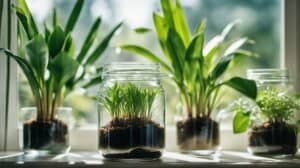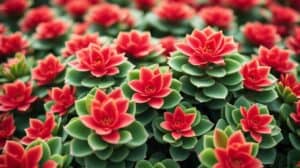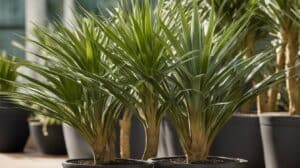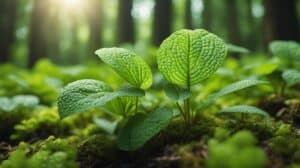Jewel orchids, also known as Ludisia discolor, are a popular choice for indoor gardening enthusiasts due to their unique and stunning foliage.
These orchids are native to Southeast Asia and are relatively easy to care for, making them a great option for beginners.
However, propagating jewel orchids can be a bit more challenging than caring for them.

Jewel orchid propagation involves growing new plants from existing ones, and it can be done through a variety of methods such as division, stem cuttings, or leaf cuttings.
Each method has its own set of challenges and requirements, but with proper care and attention, it is possible to successfully propagate jewel orchids.
In this article, we will explore the different methods of jewel orchid propagation and provide care tips to ensure your plants thrive.
Understanding Jewel Orchid (Ludisia Discolor)

Species Overview
Jewel orchid, also known as Ludisia discolor, is a beautiful and unique plant that is native to Southeast Asia.
It is a member of the orchid family and is prized for its attractive foliage rather than its flowers.
The leaves of the jewel orchid are velvety in texture and have a deep green color with maroon undertones.
The plant gets its name from the small white or pinkish flowers that resemble jewels.
Jewel orchids are relatively easy to care for and make great indoor plants. They are also popular among collectors because of their unique appearance.
While they are not as showy as some other orchids, they are still a beautiful addition to any plant collection.
Native Habitat
Jewel orchids are native to Southeast Asia, including countries like Thailand, Malaysia, and Indonesia.
They grow in the understory of tropical forests, where they receive filtered light and high humidity.
In their natural habitat, jewel orchids grow as terrestrial plants, meaning they grow in soil rather than in trees like many other orchids.
Because of their natural habitat, jewel orchids prefer warm, humid conditions and do not tolerate cold temperatures well.
They also prefer bright, indirect light and should be kept out of direct sunlight, which can scorch their leaves.
Overall, jewel orchids are a unique and beautiful addition to any plant collection.
With proper care, they can thrive indoors and provide years of enjoyment for their owners.
Jewel Orchid Propagation Techniques
Jewel orchids are a popular houseplant due to their attractive foliage and ease of care.
Propagating jewel orchids is a great way to expand your collection and share the beauty of these plants with others.
Here are three common methods of propagating jewel orchids:
Division Method
Dividing a mature jewel orchid is a simple and effective way to propagate it.
This method involves separating the plant into smaller sections, each with its own roots and leaves. To divide a jewel orchid, follow these steps:
- Carefully remove the plant from its pot and gently shake off excess soil.
- Use a clean, sharp knife or scissors to cut the plant into sections, ensuring that each section has at least one healthy stem and a few leaves.
- Plant each section in a separate pot with fresh, well-draining potting mix.
- Water the newly potted sections and keep them in a warm, humid location with bright, indirect light.
Stem Cuttings
Stem cuttings are another popular method of propagating jewel orchids.
This method involves taking a cutting from the stem of a mature plant and rooting it in water or soil.
To propagate a jewel orchid using stem cuttings, follow these steps:
- Use a clean, sharp knife or scissors to cut a healthy stem from the plant.
- Remove the lower leaves from the stem, leaving only a few at the top.
- Dip the cut end of the stem in rooting hormone to encourage root growth.
- Plant the stem in a pot with fresh, well-draining potting mix or place it in a jar of water.
- Keep the pot or jar in a warm, humid location with bright, indirect light until roots form.
Leaf Cuttings
Leaf cuttings are a less common but still effective method of propagating jewel orchids.
This method involves taking a leaf from a mature plant and using it to grow a new plant.
To propagate a jewel orchid using leaf cuttings, follow these steps:
- Use a clean, sharp knife or scissors to cut a healthy leaf from the plant.
- Cut the leaf into sections, ensuring that each section has a vein running through it.
- Place the leaf sections in a pot with fresh, well-draining potting mix.
- Water the pot and cover it with a plastic bag to create a humid environment.
- Keep the pot in a warm, bright location and mist the leaves regularly until new plants begin to grow.
By using these three methods, you can easily propagate jewel orchids and enjoy their beauty in more locations throughout your home or garden.
Essential Care for Ludisia Discolor

Lighting Requirements
Ludisia Discolor, commonly known as Jewel Orchid, prefers indirect bright light.
Direct sunlight can burn their leaves, so it’s best to place them in a spot that receives filtered light.
A north-facing window or a shaded area in your home is ideal for these plants.
Watering and Humidity
These plants require consistent moisture, but not too much water. Overwatering can lead to root rot, which can be fatal for Jewel Orchids.
It’s best to allow the top inch of soil to dry out before watering them again.
Ludisia Discolor also thrives in humid environments, so misting the leaves or placing a humidifier nearby can help keep them healthy.
Soil and Fertilization
Jewel Orchids prefer well-draining soil that’s rich in organic matter.
A mixture of peat moss, perlite, and bark can provide the right balance of moisture and nutrients.
Fertilize these plants once a month during the growing season with a balanced fertilizer.
Temperature and Airflow
Ludisia Discolor prefers warm temperatures between 65-80°F (18-27°C). Avoid placing them in areas with cold drafts or extreme temperature fluctuations.
Adequate airflow is also important for these plants, as stagnant air can lead to fungal growth.
A gentle fan or open window can provide the necessary air circulation.
By following these care tips, you can ensure that your Jewel Orchids thrive and bring beauty to your home.
Troubleshooting Common Issues

Pest Infestations
Jewel Orchids are susceptible to pests like spider mites, mealybugs, and thrips. These pests can cause damage to the leaves and flowers of the plant.
Spider mites are tiny pests that can be identified by the fine webbing they create on the plant.
Mealybugs are small, white, fluffy pests that can be found on the leaves and stems of the plant.
Thrips are tiny, slender insects that feed on the leaves and flowers of the plant.
To prevent pest infestations, it is important to keep the plant in a clean and well-ventilated area.
Regularly inspect the plant for signs of pests and treat them immediately using an insecticide or a natural remedy like neem oil.
Diseases and Disorders
Jewel Orchids can also be affected by diseases and disorders like root rot, leaf spot, and yellowing of leaves.
Root rot is caused by overwatering and can be identified by the yellowing and wilting of the leaves.
Leaf spot is caused by a fungal infection and can be identified by the black or brown spots on the leaves.
Yellowing of leaves can be caused by a lack of nutrients or exposure to direct sunlight.
To prevent diseases and disorders, it is important to provide the plant with proper care.
Avoid overwatering the plant and make sure it is planted in well-draining soil.
If the plant is affected by a fungal infection, remove the infected leaves and treat the plant with a fungicide.
Leaf and Root Problems
Jewel Orchids can also experience problems with their leaves and roots.
The leaves may become discolored, wilted, or droopy, and the roots may become brown or mushy.
These problems can be caused by a variety of factors, including overwatering, underwatering, exposure to extreme temperatures, and nutrient deficiencies.
To prevent leaf and root problems, it is important to provide the plant with proper care.
Make sure the plant is planted in well-draining soil and water it only when the top inch of soil is dry.
Avoid exposing the plant to extreme temperatures and provide it with the necessary nutrients, including nitrogen, phosphorus, and potassium.
Frequently Asked Questions

How can I propagate Ludisia discolor using stem cuttings?
Propagating Ludisia discolor using stem cuttings is a simple process.
Cut a stem with at least two nodes and place it in a potting mix that is moist but not waterlogged.
Cover the pot with a clear plastic bag to create a humid environment and place it in a warm, bright location.
After a few weeks, roots should start to grow from the nodes, and once they are established, the plant can be moved to its own pot.
What are the ideal conditions for Ludisia orchid care?
Ludisia discolor thrives in a warm, humid environment with bright, indirect light.
It prefers well-draining soil that is kept consistently moist but not waterlogged.
Temperature should be kept between 65°F and 85°F, and humidity should be around 50-70%.
Fertilize every two weeks during the growing season with a balanced orchid fertilizer.
What type of potting mix is best for jewel orchids?
A well-draining potting mix that retains moisture is best for jewel orchids. A mix of sphagnum moss, perlite, and bark is a good option.
Avoid using soil, as it can become waterlogged and lead to root rot.
Can jewel orchids be propagated in water, and if so, how?
Jewel orchids can be propagated in water, but it is not recommended.
While it is possible for roots to grow in water, they may not be strong enough to support the plant once it is transferred to soil.
Propagating in soil is a safer and more effective method.
How often should I mist my Ludisia discolor to maintain optimal health?
Misting Ludisia discolor once a day is sufficient to maintain optimal health.
Avoid misting too frequently, as it can lead to fungal growth and other issues.
Are there different varieties of Ludisia discolor, and how do they vary in care?
There are several varieties of Ludisia discolor, including ‘Alba’, ‘Nigrescens’, and ‘Red Velvet’.
While care for each variety is similar, some may require slightly different light or humidity levels to thrive.
It is important to research the specific variety you have to ensure proper care.












